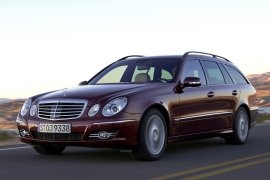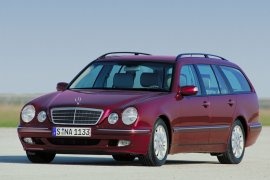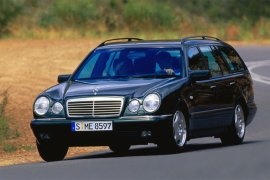
MERCEDES BENZ E-Klasse T-Modell
Generations Timeline, Specs and Pictures

The sixth generation Mercedes-Benz E-Class T-Modell comes in a more modern shape, confidently stylish and dynamic, looking the same as the Salon model through the B-pillar.
But the good thing about the station wagon doesn’t look like a van with windows on it.
In terms of the space on offer, the Mercedes-Benz E-Class Estate continues to be one of the favorites in its segment: it has a cargo volume of up to 1820 liters (64,3 cu-ft) and it offers, as an option, a third row of seats for children.
A self-levelling rear air suspension continues to be part of the vehicle concept as standard. This ensures that the Estate always stays horizontal. An optional full air-suspension is available as an option.
The instrument panel can be adorned with two optional wide, high-resolution and brilliant displays, each with a 12.3-inch screen diagonal. Located under a shared glass cover, they merge to form a widescreen cockpit. The driver may configure the fully digital display to show the information and views that are relevant for them.
There is a large variety of engines and gearboxes to choose from. The base model has a 1.6 liter turbodiesel engine that offers 160 hp and goes all the way to a 367 hp gasoline unit. If that is not enough, there are other three AMG models. Depending on the engine, the E-Class T-Model came with a 6-speed manual or a 9-speed automatic transmission.

The new Mercedes-Benz E-Klasse T Modell comes with enhanced styling, efficiency and eco performances.
With a new front end, redesigned bumpers and side view, the new estate is securing its leading position in the luxury class vehicle sector at the highest level, combining intelligent technology with superior styling. The front fascia comes with two different grilles depending the level of trim - basic and Elegance models are equipped with the classic three-dimensional Saloon grille, while the Avantgarde equipment line incorporates a sportier front end. The headlamps have been redesigned, keeping the “four-eye” look that defines the E-Klasse, and they feature LED technology as standard now. The E-Klasse Estate comes with a wide range of powerful and efficient petrol and diesel engines, all fitted with the Eco start-stop system. Further high-tech features include Collision Prevention Assist, Attention Assist, Hands-Free Access boot-lid system and Distronic Plus system with Steering Assist.

In August 2009 Mercedes-Benz revealed their new E-Klasse Estate model, based on the S 212 platform.
The German auto maker wanted to achieve with this model not only practicality and comfort, but also visual appeal. In terms of technology and safety the Mercedes-Benz E-Klasse T-Modell doesn’t disappoint. The car comes fitted with nine airbags and adaptive air suspension and self-leveling rear suspension as standard. Because the E-Klasse Estate spent many hours during development in the wind tunnel, it comes with subtle features that reduce air flow turbulence, tire threading resistance and noise levels.

After four years on the market, the third generation of the E-Class was refreshed with a well-deserved facelift and around 2000 components changed to the car.
The facelifted E-Class Estate (Station-wagon), was released at the 2006 New York International Auto Show. One of the first big surprises for the customers was that the base prices for the four and six-cylinder units remained the same as before, even though the base diesel version gained 20 more horsepower.
On the outside, the E-Class received a new bumper and grille that featured a distinctive sweepback. Mercedes-Benz enhanced the details of the twin-headlamp fascia, with a transparent upper side for a better lightning pattern. In the back, the S211 E-Class station-wagon receiver LEDs for sidelights. A new set of side sills and rear bumper was installed for the Avantgarde trim level.
On the inside, there was a new steering wheel, and the climate control system Thermatic was fitted as standard on all the range. New materials and colors were added to the options list.
The most important modifications were made under the skin. For the brakes, the facelift introduced the Adaptive brake system instead of the Sensotronic Brake Control. For the engines, the customers had a choice of thirteen versions. Six of them were new or further developed. The new top-of-the-line engine was the 5.5-liter V8 in the E 500.

The second generation of the four-eye Mercedes-Benz E-Class was introduced in 2002 at the Brussels Motor Show and the station-wagon version, named T-Model, was unveiled in October 2003.
Mercedes-Benz understood that, sometimes, a step back is the best step. That is why the 2003 T-Model variant of the E-Class was shorter than its predecessor. It didn’t offer as much trunk-space or interior room, but from the utility point of view, it was better for its customers. It was easier to park but it still offered enough room for passengers.
The 2003 E-Class T-Model featured the same twin-lamps design for its headlights, like its predecessor, but the entire front fascia was tilted rearwards or a better aerodynamic. Its raked A-pillars and sloped end confirmed the company tends to make its cars more fuel-efficient.
Inside, there was the same front slightly bolstered seats. For the rear passengers, there was enough room both for head and legs, due to its long, 2.9 (112.4”) wheelbase. The split rear-seats backseat could have been folded to increase the trunk space. For better climate comfort, the car-manufacturer installed air-vents for the rear passengers, in the rear part of the center console.
Under the hood, Mercedes-Benz offered gasoline and diesel engines. It was fitted with a 5- and 6-speed manual or 5-speed automatic. The E350 and the E500 were offered with the new, 7-speed automatic transmission. The E55 AMG was exclusively offered with the 5G-Tronic automatic. The E-Class T-Model was offered also with an all-wheel-drive system.

By 1999, the German manufacturer had taken all the step to further enhance their highly successful E-Klasse.
The vehicle was slightly redesigned, having gained new front and rear bumpers while the suspension was lowered. Interior features were enhanced while new devices found their way into the cabin such as a new fiber optics navigation system and a new 5-speed automatic transmission with manual mode. It was the same year that Mercedes discontinued the use of diesel engines in the E-Klass on North American territory while European versions were replaced by newer CDI (Common Rail) plants.

1996.
Nothing special happened that year except the E-Klasse refresh and a simultaneous rebellion against deeply-rooted design conventions. Through a constant alchemical-like process, MB styling had began the transition from bling to bland which was probably the main reason which drove the company to change the car’s appearance. The by then dull-looking rectangular head-lamps were morphed into an oval quad layout while the grille was also altered to fit the car’s new lines. Everything was retuned from front to rear end and the range ultimately saw the introduction of a new V6 unit with power and torque outputs of 221 hp and 310 Nm of maximum torque.

The E-Klasse is a mid ranged executive size cars made by the German produced Merdeses Benz.
The E initially stood for Einspritzung which is german for fuel-injection, the car has a very potent engine powering the vehicle up to very high speeds. The interior of the E-Klasse is very luxurious and well built with very much attention to detail. The design of the 1993 E-klasse was not to fancy, a more cubic shape, but made the car very stiff while going around corners. From the previous models the 1993 E-klasse received new styling to the headlamps and front grill. The car was fitted with a large variety of engines ranging from both diesel and gasoline.

The station wagon demand in the ’80s and, after a successful career, the S123 Series had to be retired.
The new S124 stepped in and brought new technologies to fill the needs.
The E-Class T-Model was launched in September 1985 at the Frankfurt International Motor Show. It carried over most of the features and styling from its sedan sibling. The rear, of course, was different. But the technical modifications went far beyond the look.
Since it was built to carry more loads, the T-Model was equipped with the new multi-link suspension and a hydro-pneumatic level adjustment suspension. That system kept the car at the same ground level, regardless of the load. Furthermore, the front suspension had received a strut-type damper.
An interesting feature for the E-Class T-Model was the option of 7-seats. In the trunk, a folding rear-facing bench-seat was installed. It was small and could have been used only by children. To improve the safety, for all the T-Model versions, the tank was located under the trunk, and, in an event of a rear crash, it fell down from its place and secured by ropes to not touch the road.
At the time of launch, there were 8 engines available for order. The 3.0-liter diesel and the 2.6-liter gasoline from the sedan were not available. But the 143 hp 3.0-liter turbodiesel was included. Also included to order were the 4-speed automatic transmission and the all-wheel-drive 4Matic system. In 1989, the diesel engines were modified to decrease the emissions, improve the fuel-efficiency, and as a result there was also a slight power increase for the 2.0- and 2.5-liter turbodiesel engines.

The estate version was unveiled at the Frankfurt Auto Show in 1977 as a complementary model with more cargo space, a slightly elevated round clearance and differently tuned suspension.
The car received the “T” designation standing for “Touring and Transport” at the same time with its brethren which all received their own letter tags to avoid confusion. Engines used were the same as seen on the sedan in both the short/long wheelbase forms except the turbocharged 200TD. Later line-up upgrades include standard power steering , an optional 5-speed manual transmission as well as a driver’s airbag and retractable steering column.

In 1965, Mercedes-Benz W110 “Heckflosse” (tailfin) received a station wagon version that enjoyed great success on some markets, while others remained almost unknown.
In 1965, the German carmaker had no intention to introduce a station wagon based on its mid-size vehicle. The Belgian company IMA was already specialized in station-wagon conversions and unveiled a modified W110 at the 1965 Brussels Motor Show in January, with the name “Universal.” In August, IMA introduced the series product with an option for an inline-six engine under the hood.
The design was similar to the original W110 model. At the front, it kept the same front fascia with a narrow and tall grille, mounted straight-up in front of the hood. The station wagon carried over its chromed, wrapped-around bumper and the entire front fascia from the W110 “Heckflosse.” Mercedes-Benz liked the idea and offered the converted vehicles in its own network in Germany. It was the same car up to the B-pillar, but its more extended roof and the side windows mounted behind the rear doors were different. In the back, the raked-forward tailgate sported a flat, rectangular rear window.
Inside, the Universal featured a similar cabin, with room for five. The folding rear-seats seatback increased both the trunk size and the loading lengths. At the front, the flat bucket seats offered adequate comfort, while the rear bench was good for up to three people.
Under the hood, the Universal version featured inline-four or inline-six engines.























































